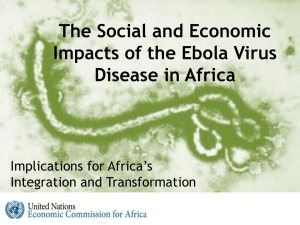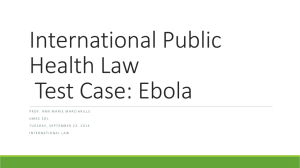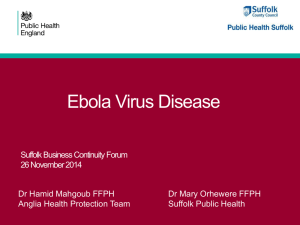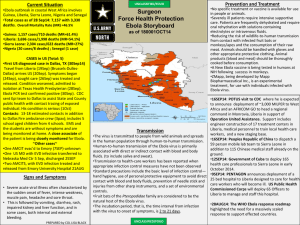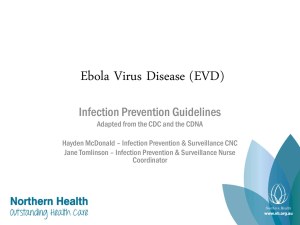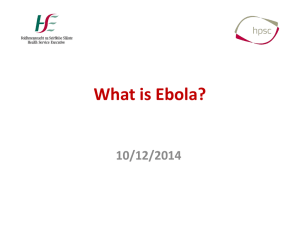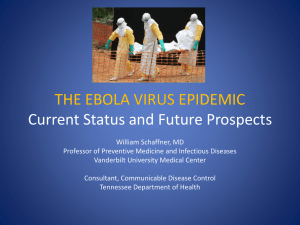Ebola-UKMPA-Nov
advertisement
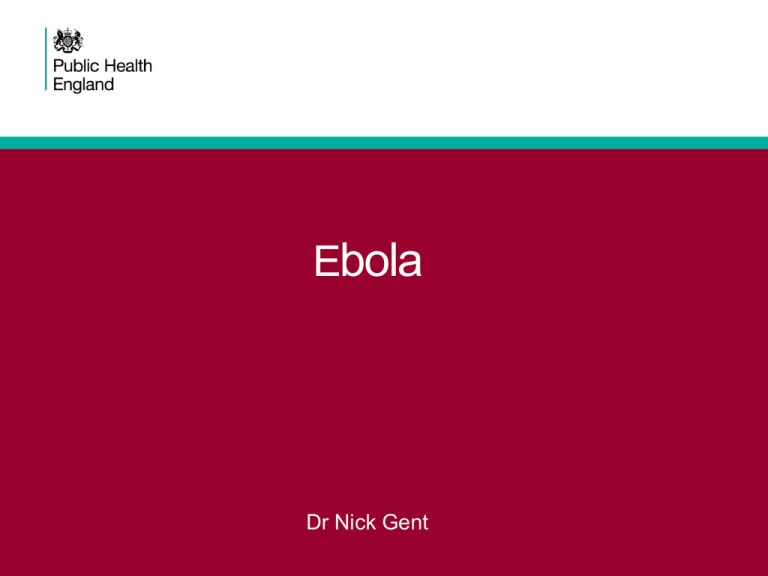
Ebola Dr Nick Gent current situation • On 23 March 2014, WHO confirmed an outbreak of Ebola virus disease (EVD) in South-eastern Guinea, the first time an outbreak has been identified in this part of Africa - now the largest known outbreak of this disease. • As of 21st November (reported by WHO -data as on 16th November): • 8 affected countries (Guinea, Liberia, Mali, Nigeria, Senegal, Sierra Leone, Spain, and the United States of America) • 15,145 confirmed, probable, and suspected cases of EVD reported – 5,420 deaths. • WHO Ebola Response Roadmap structure: country reports fall into two categories: • those with widespread and intense transmission (Guinea, Liberia, and Sierra Leone) • those with an initial case or cases, and/or with localized transmission (Nigeria, Senegal, Mali, Spain, and the United States of America) 2 Ebola UKMPA Conference symptoms of Ebola virus disease • The incubation period, that is, the time interval from infection with the virus to onset of symptoms is 2 to 21 days. Humans are not infectious until they develop symptoms. • It can be difficult to distinguish EVD from other infectious diseases such as malaria, typhoid fever and meningitis from clinical symptoms alone. • First symptoms are the sudden onset of fever, fatigue, muscle pain, headache and sore throat. This is followed by vomiting, diarrhoea, rash, symptoms of impaired kidney and liver function, and in some cases, both internal and external bleeding (e.g. oozing from the gums, blood in the stools). • Laboratory findings include low white blood cell and platelet counts and elevated liver enzymes. 3 Ebola UKMPA Conference transmission of Ebola • Principal mode of transmission: • Initially: direct contact with infected animals • Subsequently: person-to-person spread by contact with bodily fluids (including blood, diarrhoea, vomit and urine) • There is no risk of transmission during the incubation period and only low risk of transmission in the early phase of symptomatic patients • Airborne transmission has not been documented during previous EVD outbreaks • In a household study, secondary transmission took place only if direct physical contact occurred - No transmission was reported without this direct contact • EVD does not survive well in the environment and is readily destroyed by washing with soap and water and common disinfectants, including alcohol gels 4 Ebola UKMPA Conference Ebola infectivity 5 Ebola UKMPA Conference Ebola infectivity 6 • Ebola virus is spread among people through close and direct physical contact with infected body fluids • People infected with Ebola can only spread the virus to other people once they have developed symptoms. In the early stages these include fever, headache, joint and muscle pain, sore throat, and intense muscle weakness • Ebola virus is not spread through routine, social contact (such as shaking hands or sitting next to someone) with people who do not have visible symptoms • When people have no or very mild symptoms (just a low fever) the level of virus is very low and unlikely to pose a risk to others • Once people are unwell, then all body fluids (such as blood, urine, faeces, vomit, saliva and semen) are infectious, with blood, faeces and vomit being the most infectious • When someone reaches the point at which they are most infectious, they are unlikely to be in any condition to move or interact socially. The most risk is to people involved in their care and not the general public • Skin is almost certainly contaminated in late stage disease because of the impossibility of maintaining good hygiene, but other people are not at risk unless they are directly involved in caring for a person with advanced disease and without wearing personal protective equipment. • Semen can remain infectious for up to three months after recovery Ebola UKMPA Conference prevention and control Reducing the risk of human-to-human transmission • Ensuring those travelling to and working within affected countries know what to do if they develop symptoms • Case identification: ensuring suspect cases receive immediate medical attention and are isolated • Use of PPE, hand hygiene, case management and maintaining a clean environment • Conducting prompt and safe burials of the dead Surveillance and contact tracing 7 • Identifying people who may have had hazardous contact with someone infected with Ebola • Monitoring the health of contacts for 21 days • Separating the healthy from the sick and emphasising the importance of good hygiene. Ebola UKMPA Conference Preparing the health system response Raising awareness & knowledge of health care providers • Sensitise staff working at “points of entry”, in healthcare settings or involved in first response - early and advanced symptoms of viral haemorrhagic fever • Emphasise systematic questioning and recording of travel history of those with relevant symptoms and consider the possibility of EVD in person coming back from affected areas Putting procedures in place to deal with suspected cases • Follow the standard algorithms and diagnostic procedures for EVD and for common differential diagnoses at an early stage Diagnosing and managing confirmed cases • Follow the protocol for notification to Public Health England (Health Protection Team) at an early stage if an EVD case is suspected 8 Ebola UKMPA Conference screening and monitoring Enhanced screening • Screening and monitoring UK-bound air passengers, identified by the Border Force, coming on to the main routes from Liberia, Sierra Leone and Guinea • Heathrow, Gatwick and St Pancras (Eurostar), Manchester and Birmingham • Passenger ships (cruise ships) where risk is identified due to passenger mix / movements Assessment and monitoring • Passengers identified as high risk of Ebola with a raised temperature and/or other symptoms will undergo clinical assessment and, if necessary, transfer to hospital • Those identified as at an increased risk, but without symptoms will be given advice and contact details. PHE will ensure that there is daily contact with individuals at higher risk of developing disease 9 Ebola UKMPA Conference diagnosing and managing potential VHFs • Patients are considered for assessment if • Fever of ≥37.5C OR a history of fever in the past 24 hours AND • have recently visited any of the affected areas within the previous 21 days. OR • have cared for / come into contact with body fluids of / handled clinical specimens (blood, urine, faeces, tissues, laboratory cultures) from an individual or laboratory animal known or strongly suspected to have VHF • Even if meet diagnostic criteria VHF unlikely and will be managed at a local hospital • Cases on board ship to go through normal MCA agreed process • Local infectious disease specialist will discuss with imported fever service • Malaria screen essential as this is the most likely serious diagnosis 10 Ebola UKMPA Conference role of PHE 1. Management of suspected and confirmed cases 2. Management of contacts 3. Monitoring the health of returning travellers 4. Responding to enquiries from partner agencies and the community 5. Maintaining database of cases, contacts and enquiries 6. Providing guidance and a point of contact for ad hoc professional enquiries 11 Ebola UKMPA Conference Ebola virus disease: clinical management and infection control guidance - GOV.UK Viral haemorrhagic fever: ACDP algorithm and guidance on management of patients - Publications - GOV.UK https://www.gov.uk/government/uploads/system/uploads/attachment_data/file/3 77142/Algorithm_v5.pdf https://www.gov.uk/government/uploads/system/uploads/attachment_data/file/3 77223/Ebola_infection_prevention_and_control_guidance_for_primary_care.pd f https://www.gov.uk/government/uploads/system/uploads/attachment_data/file/3 77163/Ebola_summary_guidance_for_acute_trust_staff.pdf 12 Ebola UKMPA Conference key messages • Overall risk of Ebola in the UK remains low • UK has robust systems to deal with infectious diseases • Awareness has been raised at all levels of the Health Care System and with relevant Agency dealing with port of entry to the country (Border Agency and Port Health) • Enhanced screening has been implemented at main airports AND other points of entrance (St. Pancreas Eurostar station) in the UK • Ebola can only be transmitted from an infected individual to another when there is direct contact with the body fluids (blood, urine, vomit and diarrhoea) with the unprotected mucosa or broken skin (i.e. abrasions, wounds) of another person • No viable virus will have travelled as an environmental contaminant with a ship from West Africa • Probability of a case arriving by ship is very low – and this case will only be infectious if symptomatic 13 Ebola UKMPA Conference Questions? 14 Ebola UKMPA Conference

